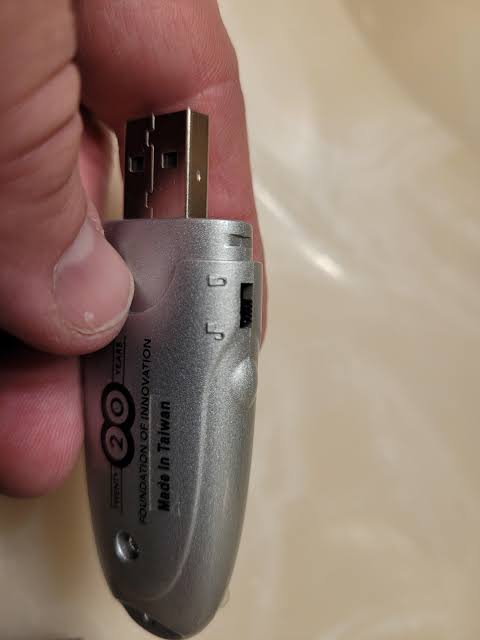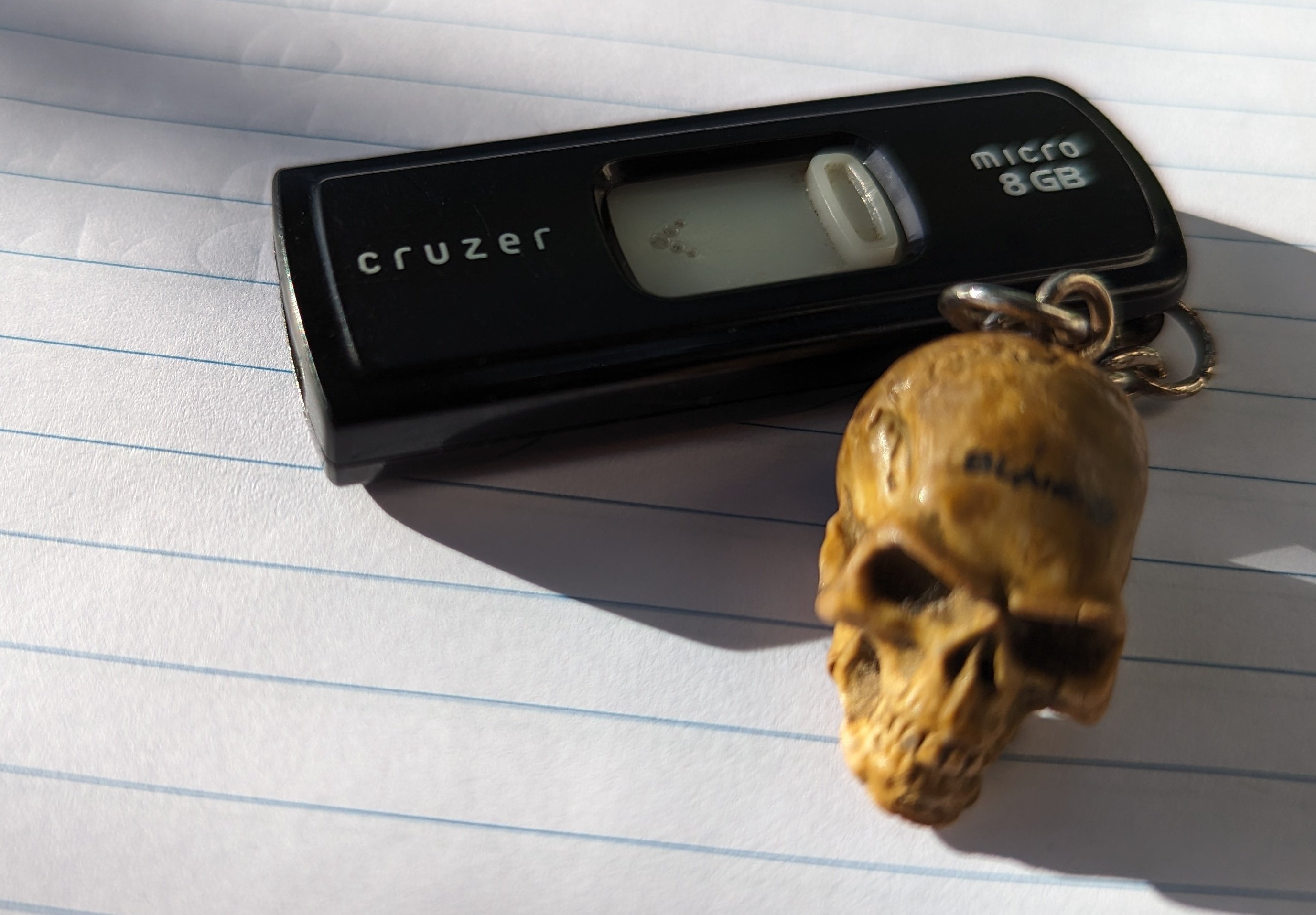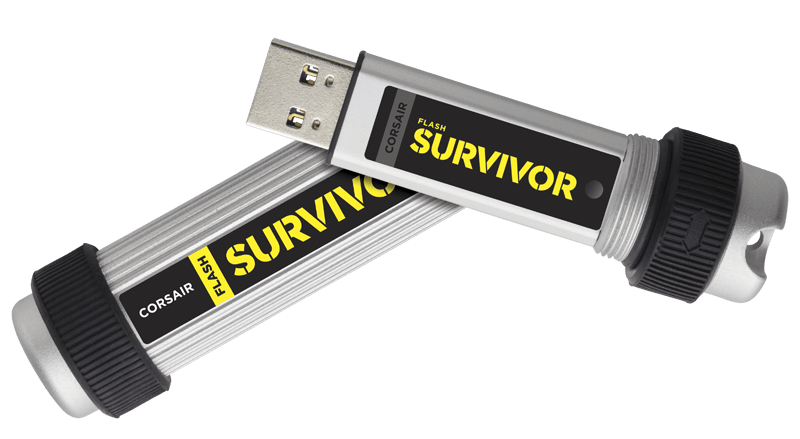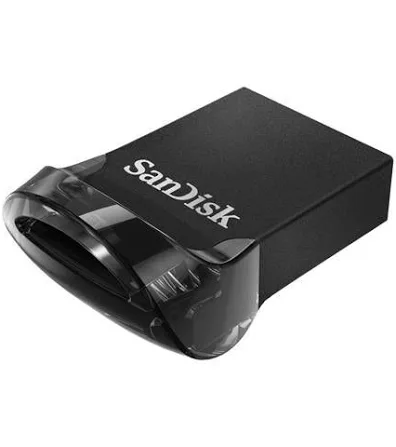Background
I have had the same Kingston DataTraveller DTSE9 since around 2010, when I was still in school. I’ve carried it on my keychain for at least 12 years and it still works, its “the old reliable”.
That said, it’s slow. Very slow. I use it mostly as a boot USB for Linux / Windows, so I need several sticks with decent random read speed, and decent write speed for when I update them.
My criteria were:
- All-metal construction for durability, including the keychain loop
- Sits well on a keychain next to keys
- Reasonable speed, including random reads.
Testing method
I evaluated the sticks in two ways.
I ran CrystalDiskMark with 256 MiB (x5) configuration.
I also measured the angle at which the USB stick sits on a keyring. I found that several of them could not sit perpendicular to a keyring it because of their geometry, which makes it difficult to comfortably use them next to keys.
At the datum of 0 degrees, the key sits perpendicular to the keyring.
Results
The competitors
Here are the 6 main competitors in this space I bought.
All transfer units are in MB/s.
| Product | Price (£) | Angle on keyring (0deg is best) | Sequential reads Q8T1 | Sequential reads Q1T1 | Random reads Q32T1 | Random reads Q1T1 | Sequential writes Q8T1 | Sequential writes Q1T1 | Random writes Q32T1 | Random writes Q1T1 |
|---|---|---|---|---|---|---|---|---|---|---|
| Corsair GTX 128GB | 65 (256GB version) | 0 | 470.214 | 429.330 | 157.436 | 19.390 | 436.990 | 414.201 | 166.829 | 38.937 |
| Samsung Bar 64GB | 10 | 55 | 305.424 | 305.268 | 14.517 | 13.428 | 36.434 | 36.247 | 20.537 | 21.619 |
| Kingston DTSE9G3 64GB | 11 | 0 | 246.705 | 244.496 | 13.756 | 13.028 | 100.236 | 110.054 | 0.484 | 0.474 |
| Integral Arc 3 | 10 | 0 | 162.336 | 161.338 | 15.567 | 11.188 | 49.457 | 47.965 | 5.032 | 4.244 |
| Kingston DataTraveller Micro 64GB | 11 | 0 | 247.000 | 245.247 | 13.788 | 12.961 | 100.932 | 101.292 | 0.496 | 0.470 |
| Sandisk Ultra Luxe 64GB | 12 | 25 | 403.863 | 399.974 | 12.438 | 12.054 | 91.835 | 91.685 | 4.272 | 4.258 |
Some additional notes:
- The Samsung Bar had really sharp corners. You might need to file them down like I did.
- Corsair GTX: the 128GB version is no longer available and the lowest capacity is 256GB. It’s more of a portable SSD in the form of a USB stick, which makes it really fast, but it’s bulkier than a normal USB stick, though not by much. Often it takes up more than one USB port because it’s wide. It’s still very good and I recommend it.
Other devices
Some related products I own but don’t qualify for this comparison but are offered up here for context.
Here’s why they don’t qualify.
-
Crucial P3 Plus: It’s an NVME SSD. Can be made portable with a good enclosure, but too bulky for what I’m looking for.
-
Samsung 860 Evo: It’s a SATA SSD, definitely not the right form factor.
-
Sandisk Ultra Curve: I bought this thinking it was made out of metal, but it was not. It’s fairly flimsy plastic.
-
Kingston DTSE9 16GB: This is my old stick. The old reliable. No longer sold, but I’ve tested its successor.
-
Samsung SD Card: It’s a 2016 MicroSD card connected to my PC via a MicroSD-SD adapter and a USB card reader. I included this as a meme.
| Product | Sequential reads Q8T1 | Sequential reads Q1T1 | Random reads Q32T1 | Random reads Q1T1 | Sequential writes Q8T1 | Sequential writes Q1T1 | Random writes Q32T1 | Random writes Q1T1 |
|---|---|---|---|---|---|---|---|---|
| Crucial P3 Plus M.2 NVME 2TB | 1598.227 | 1332.131 | 305.220 | 46.643 | 1560.989 | 1452.256 | 238.134 | 102.502 |
| Samsung 860 Evo SATA 1TB | 564.446 | 539.913 | 272.631 | 43.322 | 536.440 | 518.168 | 238.752 | 101.313 |
| Sandisk Ultra Curve | 160.091 | 158.859 | 9.271 | 9.043 | 58.680 | 60.377 | 2.902 | 3.209 |
| Old Kingston DTSE9 16GB | 18.452 | 18.220 | 8.473 | 8.096 | 13.626 | 13.629 | 0.115 | 0.026 |
| Samsung Memory Pro Plus Micro SD Card | 20.765 | 20.969 | 5.146 | 5.102 | 19.493 | 20.316 | 2.181 | 3.421 |
Conclusion
There are no clear winners in this fight.
- The Corsair GTX is the fastest in all categories by a country mile, but has a larger form-factor than other entries and higher price. Very good, but not for everyone.
- Samsung Bar has the fastest random writes, and decent performance in other metrics for its USB stick form factor, but sits awful on a keychain due to the angled hole.
- The Integral Arc 3 has solid random performance, but worst sequential performance than the rest.
- Sandisk Ultra Luxe gets the best overall balance of performance, but does not sit on the keychain super well.
- The two Kingston’s perform effectively the same, with the Micro being much more compact. That said, that can be a disadvantage on a keyring if there are adjacent items.
- All competitors (bar the GTX) had similar random reads.
For me, I’d say the right choice is either the Kingston DTSE9G3. It’s a nice upgrade over my old DTSE9 and sits nicely next to it’s grandfather. If I needed any random writes though, for copying lots of small documents like code files, I’d pick the Integral Arc 3.
This fucking rocks, you rock, thanks for making this!!
For durability and smallest features, a metal unibody types that don’t have seams are great.
For performance, I opt to have an nvme SATA enclosure that is USB 3.1 capable. Copying 15 GB in a minute or 2 is so satisfying. Plus my god being able to easily change the nvme SATA drive on the fly if needed and it being able to go up to a few TB without loss of performance is just to good
For price, nothing beats free. Just don’t expect much more than what you get.

One of these took me through university in 2002
I really miss the hardware read only switch.
Computer labs did not have front USB back in those days, so we had to choose between floppies or diving under the desks. I was in the diver club.
32MB was massive for documents at the time. It could hold your entire academic life back then.
I remember 256MB sticks were a game changer for me. 1TB still seems unnecessarily to me. You carrying Wikipedia in there?!
Wikipedia is only 110GB… https://library.kiwix.org

Bought December 2007, downtown Portland Radio Shack, which was coincidentally my last purchase from the chain.
It’s also the very last of the Disk of Death hacker series started in 1995 on Floppies.
May its light continue to shine (unnecessarily)
Shit I had one of those. Now I’m feeling all nostalgic remembering fidgetting with the slider
Still have this same usb stick and it works flawlessly
8GB hot damn. I thought I was shit hot with 2 haha.
8GB in 2007?! How much did that cost?
Still have the 4GB version of this one somewhere. Bought in the same year
Served be well over the years
Mine has been relegated to BIOS updates, still doing a great job just a bit small these days.
Pro tip from me (a pro): Never buy flash drives that aren’t one metal body. I have broke a 128GB flash drive simply by putting a tad bit too much pressure on it and misaligning the USB connector. It now doesn’t work. I also injured one by misaligning the usb in the plastic case. It still works but isn’t ideal.
Even if it is one plastic body, the plastic will chip away with insertions. My SanDisk Ultra Dual is in rough shape because of the weak plastic. Meanwhile my SanDisk Ultra Dual Luxe (the metal variant) is still pristine.
Also, don’t buy cheap flash drives if you wish to use them frequently. They have terribly slow speeds even if they use a USB 3.0 interface. They might work okay as install media which you only need to use every few months or years, but they have painfully slow write speeds.
Edit: Yes, I know the metal drives have thermal issues. But thermal issues are better then losing the entire drive because the casing chips away and exposes the connector to things that eventually kill it.
I agree of course, hence why I am only picking metal ones. I’ve lost USB sticks to broken clips and bodies.
Why would they have thermal issues? If anything, they should dissipate heat better than plastic drives.
Or is it that by thermal issues people mean that they get hot to the touch?

I bought two of these a few years ago and they are really reliable. USB 2.0 so they are slow as shit, but I still use them to install linux.
Thanks, I wish more people did their own tests and published them like this since marketing for electronics is loose at best
Yeah, about the only place I trust for electronics reviews is rtings, and usually consumer reports for household appliances. Everywhere else seems infected by the affiliate bug
I didn’t see anyone else say this so I’ll chime in: when I’ve had to keep bulky things on a keyring (a CPR pocket mask comes to mind) I’ll put it on its own small keyring and then hang that on the main keyring with the keys. It isn’t a perfect solution, but it helps a lot.
Handy tip. I used to do that too.
Also had a chain between two rings for a bit of a fidget toy 😅.
This is probably my favourite metal flashdrive of all time. I had a 1GB of the first generation and then later another usb3 one of 32GB

These days I carry one of these on my keychain.

Surprisingly fast given the size. Will do 300MB/s sequential read. About 90MB/s write
I use medicat/ventoy on it with windows 11 , debian and linux mint ISOs on it.
I did see that second one, but I realised it would not fit my criteria for the angle of the hole, so I didn’t get one.
The Sandisk one got me filesystem corruption, since it’s always super hot (especially in notebook) even in idle, to the point the controller shuts down for a second and the again on for a few. Put a tiny heatsink on it and it works since (although goofy).
Thank you thank you thank you. This is exactly what I want on Lemmy.
It’s wild just how slow most thumb drives benchmark even with recent models, the Samsung Bar at 36MB/s is just ridiculous, that’s 30 minutes of waiting to fill it up entirely!
A basic V30 microSD card is at least that fast!
Love the thorough report. I also have an Ole reliable from circa 2008. Never fails, slow as balls.
did any of them do the write fast for 5 seconds, then freeze for 10 seconds shit? that’s the worst when a pendrive does that, and I’ve experienced that with multiple drives
That’s because your PC is faster than the drive. You fill the cache quickly, then wait while it writes to flash. It’s not a big deal.
I remember having that problem with the original Kingston.
Because I didn’t manually copy large files, I couldn’t say.
If there’s any you’d like me to test this for (except the Samsung Bar, because I’ve given it away) I can do so.
Others have said this but THANK YOU SO MUCH! This is extremely valuable info for me as I pretty much only want full metal flash drives. I have a couple Samsung Bars, and I will absolutely snag a GTX.






